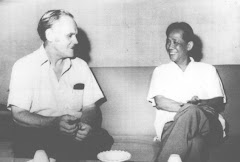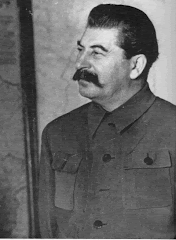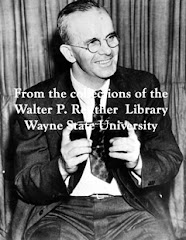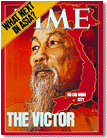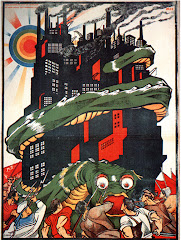
He met everyone from Martin Luther King to Dorothy Parker, Tennessee Williams to Bob Dylan. He survived the McCarthy era to record a unique oral history of his country. Now in his nineties, the great US chronicler is still raging against George Bush, Hillary Clinton and the death of radical America
The Robert Chalmers interview
Published: 21 October 2007
Terkel is presented with the National Humanities Medal by the Clintons in 1997
"You are God," I tell Studs Terkel. "Re-create the world." The writer says nothing for a couple of seconds, which is not like him. "As you seem to know," he replies, "that's a question I used to ask people. I think the best way I can respond is to tell you how one young kid answered it. He said: 'I don't want that job. That job is impossible.'"

"And these days, when you listen to the news, I imagine you can't help thinking that boy was right. How does it feel when you're 95 and almost every ideal you ever cherished is under threat; when your nation's government has become less peaceful and more bloodthirsty; less equitable and more shamelessly driven by greed? What's it like, towards the end of a lifetime devoted to civil-rights activism, to find your country led by a president more right-wing and nakedly acquisitive than any other in your memory?"
"It's true what you say. I can't deny it. At the same time, I once wrote a book called Hope Dies Last. I believe that. I might feel hopelessness, except for one thing: the young. I don't mean the young as they're portrayed in TV commercials: whores, bimbos and dummies. There are many who do not fall into those categories. The big problem is that there's no memory of the past. Our hero is the free market. People forget how the free market fell on its face way back in the Depression. And how the nation pleaded with its government and got help. Today, all these fat CEOs say we don't need government. And these fat boys get away with it, because of our collective Alzheimer's, and the power of Rupert Murdoch and CNN. There is despair in this country, sure. At the same time, we are waiting."
"For what?"
"For new voices."
We are talking in the living-room of Terkel's house in Chicago, near the shore of Lake Michigan. In 1996 he underwent a quadruple-bypass operation; three years ago he broke his neck when he tripped over a pile of his own books. He is physically frail to the point that the last of his beloved Romeo y Julieta cigars has long since been smoked. But age has not extinguished his mental alertness or mischievous energy. He is wearing the red-and-white gingham shirt and red cotton socks that have been his uniform since the 1950s. Terkel, who can manage a few steps using a cane, apologises repeatedly for not being strong enough to take me downtown for dry Martinis.

The word genius – grotesquely overused in most areas of the media – is not a term you hear disinterested observers use to describe an interviewer. But Terkel – a man with the wit, the longevity, but none of the compliant orthodoxy of an Alistair Cooke – has been the greatest American broadcaster of his, or any other, generation and he has done more than enough to earn it. '
Over the years Martin Luther King, Billie Holiday, Tennessee Williams, Bob Dylan, Louis Armstrong and Dorothy Parker, among others, have sat where I am now, face to face with the best-loved figure in Chicago. Woody Guthrie used to stay in this house. True, that was in the days before you had to bellow at Terkel in the kind of voice that, given a calm night and a favourable wind, might be audible across the state line in Indiana. It's ironic that a man who defines his role as "listening to what other people tell me" can't work his hearing aids any better than he could his tape recorder, a device he could never be trusted to operate unaided.
"I realised very early on," he says, "that the conventional way of approaching an interview was useless; that taking in a notebook full of questions, for instance, only made people feel interrogated."
Terkel broadcast daily for the best part of 50 years on Chicago station WFMT; his last regular show was 10 years ago. He developed a discursive style of interviewing, his energies devoted to capturing the voices of what many radio presenters persist in referring to as "ordinary people". One of his favourite films is Miracle in Milan by Vittorio de Sica, at the end of which a group of slum-dwellers suddenly levitate and soar into the clouds: it's as good an image as any to represent Terkel's life's achievement.
"I set out," he said, "to swallow the world."
Unusually in his industry, there is, as someone said, "absolutely nothing in Studs of 'The Big I Am'". He has every quality he once attributed to his friend, the legendary British reporter James Cameron: "The heart of the innocent, the eye of the experienced and the style of the master."
"I remember interviewing a woman at a housing project," he tells me. "She was a light-skinned African-American. Three kids running around. She's talking for the first time about her life. She stops and says: 'Have you noticed that machine is not working?' The tape isn't moving. I've pressed the wrong button by mistake. She presses the right one. From that point on, she became not only my equal but my better. And that is important, because when you are interviewing a person, that person must count."
At the end of their conversation, "the kids want to hear mummy's voice. I play the tape back. She'd given the most eloquent account you could imagine of her life; a black person's outing in a white world. It was so moving. When it finished there was a pause. She said: 'My God – I never knew I felt that way.' It can help," he adds, "to be inept."
Terkel, whose extraordinary memoir Touch and Go is published in the US on 1 November, is best known in Britain for his written collations of oral history, such as The Good War, Race, or Will the Circle be Unbroken? Reflections of Death and Rebirth. He began producing what he calls his "memory books" at the suggestion of English actor Eleanor Bron, and they are distinguished by the same qualities that resonate from his recordings: his remarkable capacity for empathy, and a unique ability to recognise lyricism in everyday conversation. Terkel exudes a benign inquisitiveness that encourages strangers to express themselves freely.
And so, over the years, a 10-year-old immigrant girl has found the courage to tell him "I may not live to grow up; my life was not promised to me." Another interviewee has described being black in America as "like wearing ill-fitting shoes". A US serviceman, speaking of Hiroshima, recalled: "We were sitting on the pier, sharpening our bayonets, when Harry dropped that beautiful bomb. The greatest thing that ever happened. Anybody sitting at the pier at that time would have agreed."
Friends say he doubts his stature as a writer; a bizarre neurosis. This, after all, is a man who once described a visit to a Soho alcoholic with the lines: "Her flat is cold, yet it isn't. There is no fireplace, yet it glows."
That said, his greatest work, I suggest, is not a book but an audio recording: Born to Live, which won the Prix Italia in 1962, and edits together the voices of a Hiroshima survivor, playwright James Baldwin, singer Miriam Makeba, and many less celebrated voices, with no commentary. It's one of the very few such recordings whose qualities are enhanced by repetition, like a great film or a symphony. WFMT still plays Born to Live every new year's morning.
"I was strongly influenced by the British director Denis Mitchell, who made Morning in the Streets [the classic 1959 BBC documentary shot in working-class districts of Manchester and Liverpool, still periodically repeated on UK television]. That film is magnificent; probably the best documentary ever made. Denis taught me that you didn't need a narrator. And that little things were important. That silence was important. And that..." Terkel pauses. "Those people on the streets... they just spoke poetry."

The ashes of his wife Ida are preserved in an urn, across the room, next to a vase of yellow daisies. They were married for 60 years; Ida died in 1999 leaving him, as he says, bereft. "Nobody will ever know how much Ida underpins his life," a friend said, some years before she died. "When she was in hospital for heart surgery, it almost destroyed him. The only sustenance he'd take was from a bottle of Scotch in his pocket. He'd stay by her bedside until he was absolutely zonked. Then they'd lift him into a wheelchair and take him home. One time, during all this, I called to ask how Ida was. I heard a strange sound, and he suddenly hung up. I realised he was crying."
Terkel suffers from what he calls "disenfranchised grief. People say that because we had 60 wonderful years together, I shouldn't grieve – but I do." He still speaks to Ida, he says. He also debates, out loud, with himself – "about international diplomacy, dogs, socks: any subject" – a habit he developed in the 1970s.
"If you go in the WFMT bathroom and he's in a cubicle, you'll hear him talking to himself," an unnamed source told the British oral historian Tony Parker, in his outstanding 1997 biography of Terkel. "You see this pair of feet, trousers round the ankles, and hear a voice saying, 'Are you seriously trying to tell me that Otello is a greater opera than Aida?' I joined in once; he just continued the conversation, including me in it. As I left, he went back to talking to himself."
"I'm known around the block as a writer and broadcaster," Terkel tells me, "but also as that old guy who talks to himself. I never learnt to drive. Why should I have? The bus was there. So one day I'm on the corner alone, waiting for the 146. I'm talking to myself, finding the audience very appreciative. Then other people arrive; I talk to them too. This one couple ignore me completely. He's wearing Gucci shoes and carrying The Wall Street Journal. She's a looker. Neiman Marcus clothes. Vanity Fair under her arm. So I told them, 'Tomorrow is Labor Day: the holiday to ' honour the unions.' The guy gives me the kind of look Noël Coward might have given a bug on his sleeve. 'We despise unions.' I fix him with my glittering eye, like the Ancient Mariner, and I ask, 'How many hours do you work a day?' He tells me eight. 'How come you don't work 18 hours a day, like your great-grandparents?' He can't answer that. 'Because four men got hanged for you.' I explain that I'm referring to the Haymarket Affair, the union dispute here in Chicago in May 1886. The bus is late. I have him pinned against the mailbox. Then I say, 'How many days a week do you work?' He says five."
Terkel laughs, and takes a sip of water. "I say: 'Five – oh, really? How come you don't work six and a half ?' He isn't sure. 'Because of the Memorial Day Massacre. These battles were fought, all for you.' I tell him about that massacre of workers, in Chicago, in 1937. He's never heard of these things before. She drops her Vanity Fair. I pick it up, being gallant. I am giving it to them now: the past. Because, like James Baldwin said, without the past, there is no present. The bus arrives. They leap in. I never see them again. But I'll bet... they live in an upscale condominium that faces the bus stop. I'll bet she looks down every morning, from the 20th floor, and he says: 'Is that old nut still down there?' And can you blame them?"
Terkel, as unembedded a reporter as ever lived, once described himself as "a guerrilla journalist. I know my terrain. Like the colonials against the British. Like the Vietnamese against us." In the time I spend with him, the only living reporter he commends with enthusiasm is Robert Fisk. He has no interest in celebrity for its own sake, and becomes especially waspish when discussing politicians.
"You try to shame them," he complains, "but they are shameless." He dismissed Ronald Reagan as "a mean-spirited prick" and castigated Margaret Thatcher for legitimising the basest of human instincts. ("It's dog eat dog," he said, in a classic Radio 4 documentary Under American Eyes, in 1987. "But we're not dogs; that's the problem.") He caricatures Tony Blair as Jeeves to George W Bush's Bertie Wooster, and speaks of Gordon Brown in terms of one of the dour agency butlers who torment Wooster when his regular man is on leave. When he wrote his 1995 book, Coming of Age, about people over 70, somebody suggested he call it Mellowing. "I said: 'Mellowing? A lot of these people are god-damn furious... they're doing what Dylan Thomas told them to: raging against the dying of the light. Did my mother mellow as she got older? Sure as hell, no. She got worse.'"
Louis (pronounced as in Carroll) Terkel was born in New York City in 1912, the youngest of four sons. His parents, Sam and Annie, were Russian Jews who fled to America in 1902. They moved to Chicago in 1921, and took over a working men's hotel, the Wells Grand, in a poor district on the west side. Louis chose his nickname in his early twenties, in homage to Studs Lonigan, hero of James T Farrell's Chicago-based crime novels. Asthmatic as a boy, he suffered from mastoiditis that permanently impaired his hearing. He shared a bed with his father who was incapacitated by chronic angina. They'd lie together, he recalls, and listen to radio broadcasts, the boy worrying about his father's heart, taking comfort from the faint voices coming through the crystal set. When Louis was 19, he would find Sam Terkel, his glasses askew, dead from a heart attack.
His mother Annie was five foot one, but an unpredictable, sometimes violent, figure. "We never were a happy family. There were always problems with my mother. She was volatile and that's putting it mildly... no one ever knew who she was going to turn on next. There was a wildness about her. She had such a readiness to hurt people. I could never understand it." His mother was "very hard on my brothers and my father; shouting at them: she humiliated them". Louis, the smallest and most vulnerable, was spared her aggression. "My brothers and my father," he says, "were better people than I was." "You've said that you more closely resemble your mother." "I'm afraid so." "Because you share what you've called her inner turbulence?" "Maybe. My father was more easygoing. I have many flaws." "Such as?" "Speaking out of turn. Calling someone a name such as, er ... craven toady. That kind of thing. My mother was very strange. A hooker arrived at the hotel one time, with her pimp. My mother and I heard him hitting the girl. My mother pounded him – she really beat and bloodied him. I remember she said: 'Touch that girl again, and I'll kill you.'"
His sensibility was permanently marked by the dysfunctional lives of the labourers who lived in and around the hotel: mostly honest workers, he says, humbled by the Depression. Touch and Go recalls the often deranged observations he heard from Wells Grand residents, and speakers at nearby "Bughouse Square", then Chicago's equivalent of Speaker's Corner. One orator, Charlie Wendorf, had lost half an arm.
"He'd say: 'Know where the rest of this is? In France. Somewhere in a trench near Château-Thierry. The French have it. Cholly Wendorf's arm is enriching the soil that grows the grapes that bring you the best Cognac money can buy. I gave it them, free of charge. Coo-vah-seer. Reemy Martin. Three Star Hennessy. I drink nothing else.'"
Room C35 at the Wells Grand was occupied by a dishwasher known simply as Civilisation. "All of Civilisation's time, and I mean all, was expended in letter-writing. He wrote to Einstein, George Bernard Shaw and Gandhi. None had the courtesy to reply." Civilization "squandered on stamps as other men do on booze and women. He was a holy fire." "It sounds like growing up in a novel." "Everything I am," he insists, "I owe to them."
Terkel went through law school in Chicago but neverpractised, drifting instead into radio drama. "I'd be called Bullets, or Bugsy, and I'd be drowned, electrocuted or shot in act one." His dying words tended to be: "Forgive me, mudder of... Oooaaawwow!"
His broadcast career proper began as a DJ in Chicago; by 1948 he was hosting his own TV show on NBC: Studs' Place, set in a diner. Though it's hard to imagine a man who is spiritually more distant from Chris Moyles or Howard Stern, certain aspects of his attitude in the studio were decades ahead of their time. Terkel was never, in his phrase, "just a moderator. I'd jump up and say: 'Aw, you're full of crap, Mike.' Mike says: 'Sit down, Studs – you're smashed,' and he's right. A black guy says: 'What do you mean by Utopia? A decent wage and a roof?' I say: 'Let's have another beer.' The black guy says: 'I gotta go to the toilet.' I say: 'Go ahead, for Christ's sake.'" '
An unflinching socialist from boyhood, his marriage to Ida, a social worker of fiercely philanthropic character, did nothing to temper his idealism. His friendships with Billie Holiday and the black opera singer Paul Robeson, among others, meant that when Senator McCarthy began blacklisting supposed subversives, it was only a matter of time before Terkel's career was derailed. Studs' Place was pulled by NBC; his column cancelled by the Chicago Sun Times.

When a network director demanded he take a loyalty oath, it was his mother's voice that rose up in him. "As a porker takes to mud, so I take to disputatiousness. I'm like analcoholic when there's booze around. I suggested, gently and politely, that he fuck off."
Once he'd refused to give names to the McCarthy's Un-American Activities Committee, Terkel spent "a lot of time at home, reading". Paul, his only son, was still an infant. The FBI would visit. "Always in pairs. I'd sit them down and ask: 'Would you guys like a triple vodka?' 'No.' 'Double?' 'No.' 'Are you sure? It's domestic.'"
His library was highly un-McCarthyist. "This one time, the two FBI men arrive and sit down. I read them passages from Thomas Paine. I say: 'Brothers, you've got to hear this.' They get irritated. One of them's taking notes. My son, who's five, goes over to him and the guy shuts his book. I ask why, and he says: 'I got my secrets.' I say: 'Why can't the boy see them? Are they pornographic?'"
In 1953 he was approached by Red Quinlan, of WFMT, who asked him to present a show called Sound of the City. "I asked Red: 'What about the blacklist?' He said: 'Piss on the blacklist.'"
Had it not been for Senator McCarthy, Terkel would most likely have wound up in Manhattan, presenting prime-time television. As it was, he bonded ever more closely with radio, and with Chicago. His blacklisting had other consequences: reinforcing his mutinous attitude to government, and intensifying his interest in life on the street. He admired the late James Cameron because, "I recognised a man who answered only to himself. His life made a mockery of the detached journalist."
Terkel met Cameron in 1966, at a time when the British reporter was being vilified in the US, "because he had described some north Vietnamese as human beings". The pair were Maced together, two years later, by Mayor Daley's officers, at the Democratic Convention riots in Chicago. Most of their fellow victims were Vietnam War protestors.
"We were two middle-aged men," Terkel said, "out looking for a Martini." At the height of the violence, which saw 36 reporters hospitalised, Cameron squinted through the pepper spray and read from a roadside hoarding: "Six good reasons for visiting Chicago."
These days, Terkel talks about the 1960s as a freak period of respite from unquestioning deference to the flag. Today, Terkel says, "We have a president who was elected fraudulently. Immigrants exploited in the worst jobs are made to feel guilty for accepting the work. It's victim against victim. Outsourcing of labour – that's back. Wire taps – they're back. This is beyond Joe McCarthy. And still the Democrats act as if they lost the 2000 election. They didn't lose. They won."
"One question you've often addressed in relation to American foreign policy is whether, in order to understand terror, you must first have experienced it. And now, post-9/11, the United States has."
"Our philosophy was: we can attack, but nobody dares attack us. After all, we beat Grenada. To attack is our right. The question that day was: how dare anybody attack us? That morning I had a meeting in a tall building in Chicago. Someone suggested we cancel. I said no. When I arrived, I was met by the sight of people running in the streets. On that day I saw refugees, right here in Chicago. American refugees, dressed in three-piece suits. All fleeing; all experiencing what it feels like to be attacked. That inverted the basis of the United States' strength, which relies upon fear. And now, in Iraq, the Democrats are saying let's get the hell out. Which raises another un-American question: how dare we lose?"
"Do you see any good ending to Bush's war in Iraq?" "You say 'Bush's war'... I believe he is just an idiot. It's more a matter of those who advised him, looking for oil." "Is there a politician who could make a difference, at this point?" "That's the big question. Hillary Clinton won't. Al Gore I think could – if he ran. Barack Obama might. And I mean, might."
"So where is the hope that you talked about going to spring from?" "From young people, like I said. From their ability to organise. I believe the internet may have an even stronger influence than people have realised. Albert Einstein said that when you join an organisation – and that could be anti-war, anti-pollution, or pro the rights of lesbians and homosexuals – Einstein said that, once you join, you have more individuality, not less. Because you are another person who wants to count."
How old would you think Terkel to be, if you encountered his thoughts only on paper, or via the internet. Seventeen? Twenty-five? As it is, after talking for two hours he's beginning to show signs of tiring, though he's too polite to say so.
There have been times during our conversation when he might have been aware of echoes from the days when he was asking the questions: notably a meeting he had in 1962 with Bertrand Russell at Penrhyndeudraeth, Gwynedd.
"He can't make out what I am saying," Terkel wrote. "I have to shout." "I am 90," Russell told him. "In the course of nature, I will soon die. My young friends have the right to many fruitful years. Let them call me fanatic."
And the more I see of Terkel, the more I'm reminded of a recording he once made of his friend, the English producer Joan Littlewood. She was talking about Brendan Behan, though the description fits the small man from Chicago as well, if not better. "He was not a tough man," Littlewood said. "The old woman on the corner, the penniless tramp, the outcast, the prisoner; these were the people he made laugh. These were the people who would follow him to the grave. Not the rich and powerful, the politicians and the movie stars. I didn't see them."
He calls in JR, his friend and carer, and asks him to come back with a dry Martini for me, and water for himself. He expresses regret that he didn't take more trouble to involve his son Paul in his work; it's the only time he becomes visibly emotional. Paul, named after Robeson, changed his name to avoid constant association with the Terkel legend. He works in financial services, his father says, "and I am extremely proud of him". Touch and Go is dedicated to Paul, under his adopted name of Dan.
The title comes from Dylan Thomas's Under Milk Wood: "And every evening at sun-down / I ask a blessing on the town / For whether we last the night or no / I'm sure it's always touch and go."
"Years before your wife died, your friends predicted you could never survive alone; at the same time you've often said that you've never been able to imagine calling a halt to your work. Do you still feel that way?"
"You're asking a tough question. It's been very, very different since Ida's been gone. I've given instructions for my ashes to be scattered next to hers, in Bughouse Square. I was 91 when I had my last operation. They changed my artery. Afterwards, I open my eyes. The surgeon's looking down at me with a rabbinical hat on. He said: 'It's all over, Studs.' I said, 'What do you mean? I'm dead?' He said: 'No. You have four more years.' I said, 'You make me sound like Nixon.' Then I realised there was only one other American as enamoured of the tape recorder as I was: Richard Nixon. The difference was our purpose."
Terkel smiles, then stops. "I have felt now and then that... quite frankly, that I would like to call it a day. Call it quits. Hang up my cleats. Or, to mix a metaphor, hang up my gloves."
"Don't do that." "I've sometimes felt I'd like to. But people say it would make them unhappy." "And deprive us of at least one more great book." "You sound like my publisher." "When I come to write this," I tell him, "I don't expect to think of a better ending than the epitaph you once suggested for yourself: 'Curiosity did not kill this cat.'"
"Well, that's true," says Terkel. "Curiosity didn't kill him." He pauses, then adds, with a look of acceptance, and no trace of self-pity: "But it didn't save him, either."







